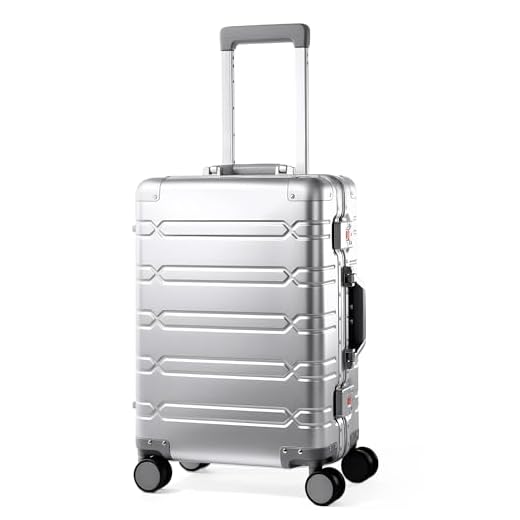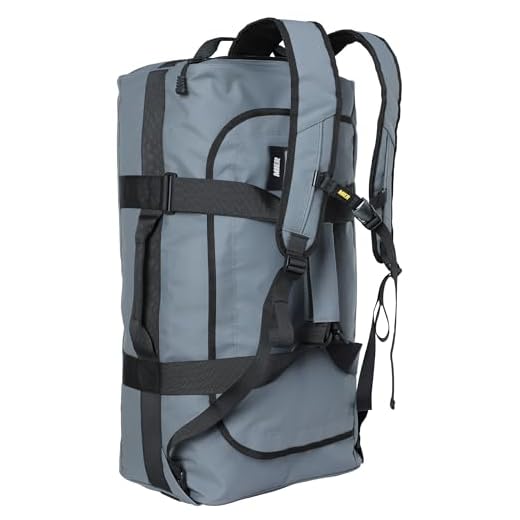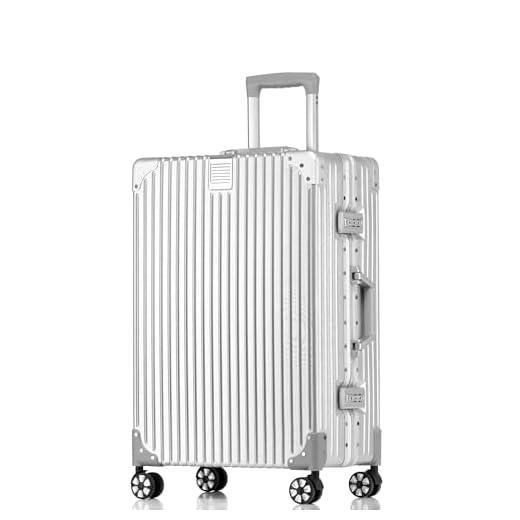





Polycarbonate stands out as an excellent option if you’re seeking high resilience in your travel case. This thermoplastic material offers impressive impact resistance and durability, crucial for withstanding the rigors of air travel.
Another viable contender is aluminum, known for its strength and sleek aesthetic. While heavier than polycarbonate, aluminum constructions provide top-level security against theft and damage, making them a preferred choice for luxury travel.
For those who prioritize lightweight options without sacrificing strength, consider ballistic nylon. This woven fabric combines outstanding abrasion resistance with a lower overall weight, ideal for frequent travelers looking for practicality.
Additionally, you might explore carbon fiber. While pricier, its extraordinary strength-to-weight ratio makes it a premium selection, appealing to those seeking an elite performance in their travel bags.
Evaluate your personal needs and travel habits to determine the right fit among these robust options, ensuring your selected bag can withstand the demands of modern travel.
Comparing Durability of Polycarbonate and Aluminum
Choosing between polycarbonate and aluminum reveals distinct advantages for those seeking durability in travel cases. Polycarbonate excels in impact resistance, absorbing shocks and resisting cracks during rough handling. This thermoplastic offers flexibility, allowing it to withstand significant stress without compromising its structure.
Aluminum, on the other hand, presents a robust exterior that is exceptionally difficult to dent or scratch. Its solid build provides a high level of security for valuables, while also reflecting a sleek, modern aesthetic. However, this metal can be subject to bending under extreme force, potentially leading to structural integrity loss.
In terms of weight, polycarbonate is lighter, making it more suitable for extended travel without added fatigue. Conversely, aluminum adds weight, which can be a disadvantage for frequent flyers facing strict luggage weight restrictions.
Considering weather resistance, polycarbonate is generally more effective at preventing moisture ingress, protecting contents from rain. Aluminum can corrode over time if not properly treated, especially in humid conditions, impacting its longevity.
For those prioritizing lightweight, flexible options that absorb impacts, polycarbonate is the preferred choice. If durability and security take precedence, aluminum stands out despite its potential drawbacks.
Impact Resistance: How Different Materials Hold Up
Polycarbonate and aluminum exhibit high resistance to impacts due to their specific properties. Polycarbonate is known for its toughness, offering exceptional durability against drops and pressure. With a significant impact resistance rating, it can absorb shocks effectively, making it a popular choice for frequent travelers.
Aluminum, while generally more rigid, boasts a high strength-to-weight ratio that enhances its performance under duress. It can withstand severe impacts without easily deforming. However, while aluminum provides robust protection, it may be prone to dents, unlike polycarbonate, which flexes without permanent damage.
When comparing these options, consider the frequency of travel and the environments you encounter. For those facing heavy packing conditions or rough handling, polycarbonate may provide superior resilience. In contrast, aluminum offers a timeless aesthetic and sturdy feel, ideal for travelers valuing style alongside strength.
Additionally, hybrid options blending these substances are available, combining the lightweight benefits of polycarbonate with the aesthetic appeal of aluminum. This approach maximizes protection while minimizing weight, catering to various travel needs.
Ultimately, selecting the appropriate option depends on individual priorities, such as aesthetic preferences, weight considerations, and specific travel needs.
Weight Considerations: The Balance of Strength and Portability
Choosing durable options entails a careful assessment between resilience and weight. Polycarbonate options weigh significantly less than aluminum counterparts, offering travelers ease of transport while maintaining robustness.
Weight Comparison
When evaluating various choices, polycarbonate is generally 30-50% lighter than aluminum. This lightweight characteristic allows for easier handling and maneuverability, especially when navigating busy airports or transporting items over long distances.
Portability Trade-offs
Travelers must consider how weight affects overall usability. Selecting a heavier option could impede mobility, while a lighter variant may lack the desired durability. Noteworthy is that lighter choices often have high impact resistance, providing adequate protection against everyday wear and tear.
| Type | Weight (Approx.) | Strength Rating |
|---|---|---|
| Polycarbonate | 4-8 lbs | Medium to High |
| Aluminum | 8-12 lbs | High |
Ultimately, selecting a travel option necessitates evaluating personal needs alongside specific weight values. Prioritize ease of transport while ensuring sufficient durability for frequent trips.
Water Resistance: Best Fabrics for Travel in Wet Conditions
Nylon and polyester are top choices due to their inherent resistance to moisture. These synthetic fabrics repel water, making them ideal for unexpected rain or splashes. When choosing bags, look for those labeled as water-resistant or waterproof, as they often feature treated surfaces that enhance their protective capabilities.
TPU (thermoplastic polyurethane) coatings offer exceptional waterproofing while maintaining flexibility. This makes it a popular option for bags designed for outdoor excursions or in rainy climates, where durability and moisture resistance are paramount.
Canvas treated with a water-repellent finish is another reliable alternative. While traditional canvas absorbs water, treated versions provide a good balance between breathability and moisture defense, making them suitable for casual use.
For extreme conditions, consider bags with sealed seams and waterproof zippers. These features prevent water from seeping into compartments, protecting valuable contents during heavy rain or accidental submersions.
Investing in high-quality protective gear, like a best gym bag deodorizer, can enhance your travel experience by keeping items dry and fresh. Ensuring your bag is well-suited for wet environments can prolong its lifespan and maintain its functionality over time.
Cost Analysis: Investing in High-Quality Luggage Materials
Investing in premium grade options yields long-term savings. While upfront costs may be higher, durability reduces replacement frequency. High-performance composites or alloys often resist wear and tear efficiently, translating to fewer unforeseen expenses.
Consider the lifecycle cost by calculating not just the purchase price, but also the potential need for repairs and replacements. A well-constructed hard shell made from polycarbonate or aluminum can withstand the rigors of frequent travel, therefore minimizing potential expenditures linked to damage.
Warranty programs often accompany these robust products, adding value and security to your investment. Reviewing warranties can highlight brands that stand behind their products, showcasing their commitment to quality.
Moreover, enhanced features like built-in water resistance or lightweight designs contribute to convenience and functionality, making high-end selections a practical choice. A smart investment might seem pricier initially, but savings can accumulate over time, comparable to investing in a best cylinder lawn mower for small lawns that is built to last.
Budget accordingly to match your travel style and frequency. Individuals traveling frequently may find premium selections beneficial, as they provide reliability and efficiency. Focus on evaluating the price against its potential value to ensure a satisfactory purchase experience.
Real-Life Performance: User Experiences with Various Materials
Reviews consistently highlight how polycarbonate excels in durability while maintaining a lightweight profile. Users report ease of handling, especially during extended trips where mobility is crucial.
Feedback on Polycarbonate
- Many travelers appreciate the scratch resistance of polycarbonate shells, stating that their suitcases remain visually appealing even after numerous trips.
- Users note that polycarbonate absorbs impact well, often surviving rough handling at airports with minimal damage.
Insights on Aluminum
- Aluminum cases receive high praise for their aesthetic and robust feel, often regarded as more stylish among frequent flyers.
- However, reports indicate that they can sustain dents from heavy impacts, potentially compromising their clean lines. Owners recommend using additional padding or internal support.
Water resistance is another area where personal experiences provide clarity. Many owners of polycarbonate suitcases report satisfaction with the water-resistant capabilities, stating that their belongings stayed dry even during unexpected downpours.
In contrast, aluminum users advise caution, as unsealed edges and joints may allow moisture penetration, leading to interior damage under wet conditions. Therefore, for travel in rainy climates, polycarbonate is often favored.
Weight vs. Strength
Reports on weight management offer valuable insights; frequent travelers emphasize the ease of lifting and carrying polycarbonate models, especially for those who prefer to avoid checked baggage fees. Conversely, aluminum’s significant heft is a common drawback, despite its elegant design.
Cost is a significant factor; feedback indicates that while aluminum tends to command higher prices due to its robust construction and aesthetic appeal, many users feel polycarbonate offers superior value through its combination of affordability and performance across multiple journeys.
FAQ:
What materials are considered the strongest for luggage?
The strongest materials typically used for luggage include polycarbonate, aluminum, and ballistic nylon. Polycarbonate is a type of plastic known for its high impact resistance, making it ideal for hardshell suitcases. Aluminum is also very strong and durable, offering a sleek appearance and good protection, although it can be heavier and more expensive. Ballistic nylon is a woven nylon fabric designed to resist abrasions and tears, often used for soft-sided luggage.
How does the weight of the luggage material affect travel convenience?
The weight of the luggage material can significantly influence convenience during travel. Lightweight materials like polycarbonate allow travelers to maximize their packing capacity without exceeding airline weight limits. In contrast, heavier materials, such as aluminum, might reduce the amount of belongings that can be packed within allowable limits. Opting for lighter luggage can make it easier to maneuver through airports and transport from one location to another.
Which material offers the best protection for fragile items in luggage?
For fragile items, hardshell luggage made from polycarbonate or aluminum is generally considered the best option. These materials provide a sturdy exterior that can absorb impact from bumps and drops, helping to protect delicate contents inside. Soft-sided luggage, often made of materials like ballistic nylon, may not provide the same level of protection against crushing forces, making it less suitable for fragile items.
Are there any downsides to using aluminum luggage?
While aluminum luggage is known for its strength and durability, there are some downsides. One major concern is its weight; aluminum cases can be significantly heavier than their polycarbonate counterparts, which may not be ideal for travelers concerned with weight limits. Additionally, aluminum can dent or scratch easily, which might impact its aesthetic appeal. Finally, the cost of aluminum luggage tends to be higher, making it a less budget-friendly option.








